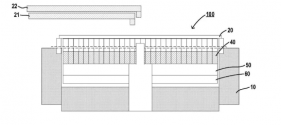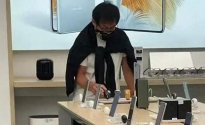You are using an out of date browser. It may not display this or other websites correctly.
You should upgrade or use an alternative browser.
You should upgrade or use an alternative browser.
Chinese semiconductor industry
- Thread starter Hendrik_2000
- Start date
- Status
- Not open for further replies.
well, if they don't unveil it tomorrow, then they might never do it. Tomorrow is the unveiling of the wearables and new AITO M7
so I think the important part in there given my last post is that the domestic supply chain gives top of the class camera & 5G connectivity
another break through
first fully independently developed electronic-grade silicon core cleaning equipment is about to be delivered to customers
so I think the important part in there given my last post is that the domestic supply chain gives top of the class camera & 5G connectivity
another break through
first fully independently developed electronic-grade silicon core cleaning equipment is about to be delivered to customers
Huawei discloses patents for "wafer processing equipment and semiconductor manufacturing equipment"
Tianyancha shows that Huawei Technologies Co., Ltd. has recently added multiple pieces of patent information, including one invention patent titled "Wafer Processing Equipment and Semiconductor Manufacturing Equipment" with the public number CN116705644A.

The patent abstract shows that the present disclosure relates to wafer processing equipment and semiconductor manufacturing equipment. The wafer processing apparatus includes: a wafer support device configured to support the wafer; and a light source array positioned in a support side direction of the wafer and adapted to perform light radiation heating of the wafer. ; wherein the light source array is configured to project a plurality of light spots for the optical radiation heating to the surface of the wafer located on the support side, so that at least all the light spots in the radial direction of the wafer The light spots are adjacent to each other and do not overlap with each other. It will be appreciated that in this manner, the heating differentiation of the wafer at least in the radial direction can be made clearer, thus contributing to the improvement of spatial resolution of temperature control in processes such as wafer drying.
Huawei pointed out that driven by Moore's Law, chip integration continues to increase, the characteristic size of a single transistor continues to shrink, and the aspect ratio of the device structure continues to increase, posing challenges to the wet cleaning and drying processes in the semiconductor manufacturing process. The purpose of the above-mentioned patent is to provide an improved wafer processing equipment, which can at least improve the temperature control spatial resolution of the wafer.
It's so unfair how about me? people call me a diehard Huawei fanboy in this forum and yet Huawei didn't acknowledge the effort I made.Jackie Chan trying but failing to get a Mate 60 Pro in Chengdu.
View attachment 118580
View attachment 118581
CEO Yu Chengdong saw this on social media and sent a phone to Jackie Chan for free.
Zhongyin Microelectronics received nearly 100 million yuan in Series A+ financing and continues to build an advanced technology platform for IC design
Zhongyin Microelectronics (Nanjing) Co., Ltd., a leader in China's advanced IC design technology platform, announced the completion of an A+ round of financing of nearly 100 million yuan. This round of financing introduced well-known industrial investment institutions such as Shangqi Capital and China Unicom Venture Capital. The addition of industrial capital can greatly enhance the industrial synergy between Zhongyin Microelectronics and upstream and downstream industries, further promote in-depth cooperation between the upstream and downstream industry chains, empower Zhongyin Microelectronics' sustainable development, and enhance the core competitiveness of the company.
Industry first | Jingsheng Machinery Electronics Company's Huixiang electro-hydraulic 12-inch transverse magnetic field exceeded 5000Gs for the first time

Huixiang Electro-hydraulics, a subsidiary of Jingsheng Electromechanical Holdings, has been focusing on the research and development and sales of magnetic fluid sealing technology, superconducting magnet systems for semiconductor single crystal furnaces, and exhaust gas treatment devices since 2016. It leads the industry in technology and scale and is a national-level professional Jingte's new "little giant" enterprise. This time, Huixiang's electro-hydraulic 12-inch dry transverse superconducting magnetic field has exceeded 5000Gs, breaking the situation that there are no domestic MCZ superconducting magnet companies that can stably mass-produce 5000Gs central magnetic field, establishing a leading position in the industry.
Currently, international MCZ superconducting magnet manufacturing companies use 3000Gs-4500Gs as regular products, and achieving stronger magnetic fields is an important breakthrough direction in the industry. To generate a magnetic field of up to 5000Gs in a room temperature space with a diameter of more than 1600mm, it is necessary to overcome the strong electromagnetic force and meet the operating conditions without liquid helium, which is a huge challenge to superconducting magnet design, manufacturing process and many other aspects. This time, the central magnetic field of the semiconductor-grade dry superconducting magnet independently developed by Huixiang Electro-hydraulic has exceeded 5000Gs. This is a major achievement of years of technological accumulation and unremitting innovation. It means that Huixiang Electro-hydraulic has superconducting magnets that are in sync with international technology. Customized R&D capabilities.
Jingsheng Electromechanical has always been focusing on overcoming the industry’s “stuck neck” technical difficulties. The arrival of this “5000Gs” superconducting magnet will greatly improve the crystal pulling effect of the equipment, lay the foundation for high-end semiconductor crystal pulling technology, and meet the needs of the semiconductor industry. The differentiated needs of Czochralski silicon single crystal technology help customers create greater benefits.
In the future, Jingsheng Electromechanical will continue to adhere to the development strategy of "advanced materials, advanced equipment", seize the commanding heights of key technologies, serve national strategic security, dare to be the first, dare to make breakthroughs, demonstrate the responsibility of domestic manufacturing enterprises, and promote the high-level development of my country's semiconductor industry. Quality development contributes more.
Guobo electronics say
companies RF IC product phase 1 has completed construction and they moved in the equipment in 1st half of the year.
T/R module production has increased. Production capacity is fully utilized.
phase 2 construction has started in Ningbo. This is going to seriously increase their production. Those AESA radars will keep getting cheaper and better
companies RF IC product phase 1 has completed construction and they moved in the equipment in 1st half of the year.
T/R module production has increased. Production capacity is fully utilized.
phase 2 construction has started in Ningbo. This is going to seriously increase their production. Those AESA radars will keep getting cheaper and better
What are you taking about. Definitely not all western media. BBC did not really acknowledge the news. They had a segment on how the brave Phillipines were standing up to china as David vs Goliath but failed to report the rally David vs Goliath in Huawei vs the US of A. Typical. That's why I don't put any credence in the BBC.Really?All Western media I have seen so far,quotes Techinsights report,say that Huawei chip was made by SMIC 7nm
I have high hopes for the SSMB EUV. I'm not an expert on particle physics, but from what I can tell, the SSMB EUV is basically a normal synchrotron that has a special array of magnetic undulators and laser that produce simulate the electrons to produce the EUV beam. But apart from the specifically built array of lasers and magnetic undulators that have to be situated next to the beamline, it's otherwise a normal synchrotron. It's not some completely brand new machine that has never been assembled before, with thousands of moving parts and a hundred thousand components. Synchrotron have been a thing since the 50s, and there's dozens of them in operation around the world today. And they can be build without ultra ultra specialised parts or companies.
And synchrotron and using them as a light source is a very mature field. Unlike ASML's EUV machine that can only really be assembled by them, around a dozen countries and companies can produce their own synchrotron and storage rings and have done so for decades. So there shouldn't be a bottleneck or lack of experience in building the majority of the synchrotron. The only bottleneck will be the special laser and magnet undulators used in actually producing the beam, but the main bulk of construction of the large machine shouldn't have any issues. Engineers and physicists also won't be in a short supply for the operation of the synchrotron, since they're a very mature technology at this point.
We might see the prototype SSMB EUV under construction get finished a lot faster than we thought, if 90% of it's construction is similar to the existing synchrotrons already in China. Hell, even if there's issues with the laser and the undulator, we might see multiple of the basic synchrotron built first and the laser/magnet undulators installed after the issues have been sorted out.
It depends on how hard it is to produce the special laser/magnet undulators how to control the laser/magnet undulators to produce the desired wavelength, but those are mainly controlled by computers/A.I which are getting better and better every year. Not to mention that undulators being used to control a synchrotron/FEL are also a very mature technology. Which is to say I can see the EUV light source being ready before the optical system, mask, EUV photoresist etc etc, with the main bottleneck being the other systems and how to integrate the EUV light source into a singular system. Like they build the synchrotron, have the laser and undulator installed, turn it on and with a few days of tweaking succeed in getting the desired EUV beam that they need.
Having the EUV light source be ready before the other components are ready could be beneficial, you could test your various photoresist, masks etc etc on the very same light source that they are designed to be integrated with.
Which would be funny if the most complicated part of a EUV machine, the light source, was the first part to be finished or one of the easiest and ASML chased after the more complicated LPP method after more than a decade just because the steady-state microbunching technique wasn't invented until 2010.
And synchrotron and using them as a light source is a very mature field. Unlike ASML's EUV machine that can only really be assembled by them, around a dozen countries and companies can produce their own synchrotron and storage rings and have done so for decades. So there shouldn't be a bottleneck or lack of experience in building the majority of the synchrotron. The only bottleneck will be the special laser and magnet undulators used in actually producing the beam, but the main bulk of construction of the large machine shouldn't have any issues. Engineers and physicists also won't be in a short supply for the operation of the synchrotron, since they're a very mature technology at this point.
We might see the prototype SSMB EUV under construction get finished a lot faster than we thought, if 90% of it's construction is similar to the existing synchrotrons already in China. Hell, even if there's issues with the laser and the undulator, we might see multiple of the basic synchrotron built first and the laser/magnet undulators installed after the issues have been sorted out.
It depends on how hard it is to produce the special laser/magnet undulators how to control the laser/magnet undulators to produce the desired wavelength, but those are mainly controlled by computers/A.I which are getting better and better every year. Not to mention that undulators being used to control a synchrotron/FEL are also a very mature technology. Which is to say I can see the EUV light source being ready before the optical system, mask, EUV photoresist etc etc, with the main bottleneck being the other systems and how to integrate the EUV light source into a singular system. Like they build the synchrotron, have the laser and undulator installed, turn it on and with a few days of tweaking succeed in getting the desired EUV beam that they need.
Having the EUV light source be ready before the other components are ready could be beneficial, you could test your various photoresist, masks etc etc on the very same light source that they are designed to be integrated with.
Which would be funny if the most complicated part of a EUV machine, the light source, was the first part to be finished or one of the easiest and ASML chased after the more complicated LPP method after more than a decade just because the steady-state microbunching technique wasn't invented until 2010.
- Status
- Not open for further replies.


